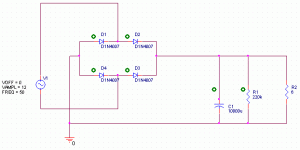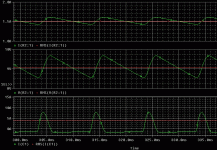Hi,
I am working on a low voltage (<10V), high current (>1.5A) power supply. It seems the ripple current is about 10A. Many caps except computer grade ones are rated at about 3-4A ripple current. Do I need a cap with rated ripple current = 10A ? or Is it safe to work with a cap having rated ripple current = 3-4A ? Does rated ripple current specified for a capacitor is continous sinusoidal rms value ? Since the ripple current drawn is not a pure sinusoid, how to calculate its effective value comparing to rated ripple current ?
Thanks in advance.
MB
I am working on a low voltage (<10V), high current (>1.5A) power supply. It seems the ripple current is about 10A. Many caps except computer grade ones are rated at about 3-4A ripple current. Do I need a cap with rated ripple current = 10A ? or Is it safe to work with a cap having rated ripple current = 3-4A ? Does rated ripple current specified for a capacitor is continous sinusoidal rms value ? Since the ripple current drawn is not a pure sinusoid, how to calculate its effective value comparing to rated ripple current ?
Thanks in advance.
MB
It seems unlikely that ripple current would be 10A with a 1.5A supply... (10A peak to peak?) but you can parallel several caps to carry more current. Also, higher voltage caps of the same value have lower ESR (more plate area), so can carry more current.
If you measure ripple current, be sure to use an RMS responding meter, as the typical DVM will read low with this waveform (about 20% or so in my experience) RMS is the value that matters, as it's the "heating" value.
If you measure ripple current, be sure to use an RMS responding meter, as the typical DVM will read low with this waveform (about 20% or so in my experience) RMS is the value that matters, as it's the "heating" value.
A sample circuit from Orcad is attached with its plots.
The rms value of ripple current is 4A. Is the rated ripple current of capacitors in datasheets represents an rms value ?
As I know, the ESR and transformer/diode resistances decreases the the ripple current. Do I need to model those resistances ? or Is it better to select a capacitor for this design maximum value ?
PS: I dont have a true RMS DMM, I cannot measure it at the moment.
The rms value of ripple current is 4A. Is the rated ripple current of capacitors in datasheets represents an rms value ?
As I know, the ESR and transformer/diode resistances decreases the the ripple current. Do I need to model those resistances ? or Is it better to select a capacitor for this design maximum value ?
PS: I dont have a true RMS DMM, I cannot measure it at the moment.
Attachments
"As I know, the ESR and transformer/diode resistances decreases the the ripple current. Do I need to model those resistances? or Is it better to select a capacitor for this design maximum value?"
I would add some series resistance between the voltage source and the diodes to simulate the resistance of the transformer secondary.
I would add some series resistance between the voltage source and the diodes to simulate the resistance of the transformer secondary.
Yes that is correct, the RMS value of ripple current is what is given in datasheets.The rms value of ripple current is 4A. Is the rated ripple current of capacitors in datasheets represents an rms value ?
Yes, ripple current is dependant on resistance in transformer and ESR of caps so you need to use the correct values to get the real result. The ripple current can not exceed the calculated value so if you use correct values for resitance and ESR the ripple current you calculate is the maximum value and a capacitor that can handle this is OK.As I know, the ESR and transformer/diode resistances decreases the the ripple current. Do I need to model those resistances ? or Is it better to select a capacitor for this design maximum value ?
Your ORCAD schematic need to be complemented with series resistance, ESR and inducatnce of capacitors.
Regards Hans
Series resistance of transformer (n:1) is Rpri / (n * n) + Rsec, right ?
A capacitor has a rated ripple current of 3.2A @ 85C. Assuming the ambient temperature is 50C. If I use something like 6.4A (that is the ripple temperature coefficient * rated ripple), is its core rises to the same value as 3.2A@85C ? So its life is same as predicted at full load, max temperature, max ripple.
Regards,
MB
A capacitor has a rated ripple current of 3.2A @ 85C. Assuming the ambient temperature is 50C. If I use something like 6.4A (that is the ripple temperature coefficient * rated ripple), is its core rises to the same value as 3.2A@85C ? So its life is same as predicted at full load, max temperature, max ripple.
Regards,
MB
Yes, I don't have the same cap data sheet, but I think you have it right. But the rated life may be only 1000-5000 hours - months not years! Each 10 degree reduction doubles the life - reduce it 30 degrees and it's an 8 times.
For a SMALL transformer, equivalent source resistance might be 10% of the load - another way to say it is that it has 10% regulation. It's a matter of economics - it's cheaper to throw away 10% of the input power than to double the transformer capacity and only save a few percent. Efficiency isn't free...
Of course if you know the actual resistance, model it. It affects your output voltage as well as ripple current.
For a SMALL transformer, equivalent source resistance might be 10% of the load - another way to say it is that it has 10% regulation. It's a matter of economics - it's cheaper to throw away 10% of the input power than to double the transformer capacity and only save a few percent. Efficiency isn't free...
Of course if you know the actual resistance, model it. It affects your output voltage as well as ripple current.
- Status
- This old topic is closed. If you want to reopen this topic, contact a moderator using the "Report Post" button.
- Home
- Design & Build
- Parts
- psu caps

